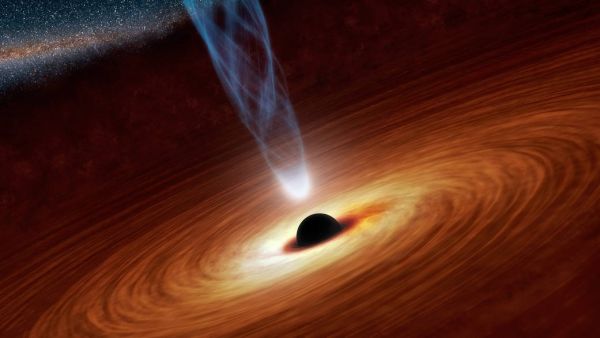How many black holes are there in the universe?

Short answer: a lot.

Black holes are notoriously hard to detect, since they are as black as the space surrounding them. We can only pinpoint them in special circumstances, like when they pull down gas from a neighboring star or merge together, releasing a flood of gravitational waves.
So how many black holes are out there? To answer the question, astronomers have to turn to theoretical calculations to make estimates. In a recent study, researchers determined that there are potentially millions of yet-to-be-detected small black holes in our cosmic neighborhood. This means that about 1% of all the matter in the universe is bound up inside black holes.
Related: Black holes of the universe (images)
Black hole ingredients
To make a black hole, you need to make stars, because black holes come from the deaths of stars. So to figure out how many black holes are in the universe, the researchers behind the study, which recently appeared in the preprint journal arXiv and has been accepted for publication in The Astrophysical Journal, had to take a few steps back.
The first step is to model galaxy evolution over the billions of years of cosmic history. Galaxies are the homes of stars, after all, and their overall evolution affects how many of each kind of star appears inside them. For example, some galaxies can steadily form new stars year after cosmic year. Others may suffer merger events that trigger a round of incredibly high star formation, only for them to burn out and produce nothing of note ever again.
The astronomers took known observations of galaxy statistics across cosmic time, noting the general trend of galactic merger rates and demographics. Another key factor is the so-called "metallicity" of a galaxy, which is a measure of the amount of elements other than hydrogen and helium inside a galaxy (astronomers call these "metals"). Bigger galaxies will have more gas, which enables them to form more stars. But more metals can enhance the cooling of gas, which in turn helps galaxies to efficiently churn out new stars.
Black hole recipes
With these building blocks, the astronomers had a model of the stellar population within galaxies, telling them how many small stars, medium stars and big stars appear in the universe.
Get the world’s most fascinating discoveries delivered straight to your inbox.
And then they needed to trace the evolution — and most importantly, deaths — of those stars. To do that, they turned to simulations, which connect the properties of a particular star (its mass and metallicity) to its lifetime and eventual demise. Only a fraction of the very largest stars produce black holes, and those simulations tell the astronomers what percentage of a galaxy's stars go lights-out every year.
Next, the astronomers had to track the evolution of binary systems, as black holes can feed off of sibling stars, becoming engorged on their gas in the process. Thus a black hole formed in a binary system will end up being larger than a black hole born solo.
As the black holes age, they continue to feed on any surrounding gas, which the astronomers also estimated. Lastly, occasionally black holes find each other in the darkness of interstellar space and merge together. So to produce an accurate survey, the astronomers had to estimate the rate of black-hole mergers within each galaxy.
Related: Scientists spot merger of two mismatched black holes
The great black hole census
Putting all the pieces together, the astronomers were able to track the population of black holes over the course of billions of years. They produced what is called a "mass function," which is a sort of astronomical census, reporting how many of each size of black hole exists at any point in time.
Not surprisingly, the largest black holes, called supermassive black holes, are much rarer than their smaller cousins. The researchers found that in every cubic megaparsec of space (where a megaparsec is one million parsecs, or 3.26 million light-years), our universe hosts roughly 50 million solar masses worth of black holes. If each black hole is a few times the mass of the sun, that translates to around 10 million individual black holes in that same volume.
To put that in perspective, the total amount of mass contained by black holes is about 10% of the mass contained in stars. So for all the stars you see in the night sky, there are a lot of black holes lurking between them.
Supermassive black holes, on the other hand, are extremely rare, with each galaxy usually hosting only one of those monsters.
Altogether, black holes account for about 1% of all the baryonic (as in, not dark matter) matter in the cosmos today. By far most of the baryonic matter is found in loose nebulae.
But still, that's nothing to sneeze at, and it means that black holes are frighteningly common.
Paul M. Sutter is an astrophysicist at SUNY Stony Brook and the Flatiron Institute, host of "Ask a Spaceman" and "Space Radio," and author of "How to Die in Space." Sutter contributed this article to Space.com's Expert Voices: Op-Ed & Insights.
Follow us on Twitter @Spacedotcom or on Facebook.

Paul M. Sutter is a research professor in astrophysics at SUNY Stony Brook University and the Flatiron Institute in New York City. He regularly appears on TV and podcasts, including "Ask a Spaceman." He is the author of two books, "Your Place in the Universe" and "How to Die in Space," and is a regular contributor to Space.com, Live Science, and more. Paul received his PhD in Physics from the University of Illinois at Urbana-Champaign in 2011, and spent three years at the Paris Institute of Astrophysics, followed by a research fellowship in Trieste, Italy.


